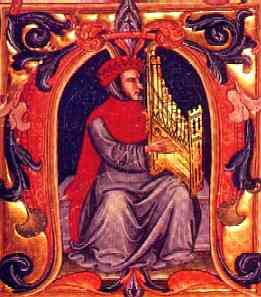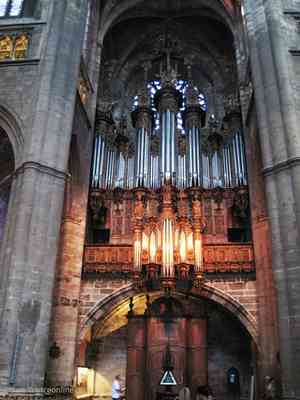


Francesco Landini
Bearing a miniature organ called a portative
Source:
Wikipedia
Likely born in Florence, Italy, circa 1335, Francesco Landini was Southern Europe's reply to Machaut in France a generation or so earlier. Landini would establish himself as one of Italy's Italy's preeminent composers of the 14th century. Preceding him by some seventy years was Dante Alighieri whose 'Divine Comedy' arrived in the early 14th century prior to Landini's birth. Also setting the cultural stage, at least in poetry, were Landini's older contemporaries, Francesco Petrarca (b 1304 d 1374) and Giovanni Boccaccio (b 1313 d 1375). The years of Landini's major musical activity between about 1360 and 1397, he is a prime example of the Trecento period, that is, the early emergence of the Renaissance in the latter 14th century toward its bloom in the 15th and 16th centuries. The Trecento is also called the Italian ars nova. The term "Renaissance" didn't arrive to common usage until 1858 when it was coined by French historian, Jules Michelet. The term was engraved for all time in 1860 upon the publication of Jacob Burckhardt's tome, 'The Civilization of the Renaissance in Italy'. With Landini one witnesses music shifting from medieval toward the Renaissance to come.
Landini's father set his son's stage as a painter in Giotto's school. Landini, however, never saw the stage, as in Shakespeare's "All the world's a stage" in 'As You Like It', for he was born blind. He was otherwise a composer, poet, singer and multi-instrumentalist who favored the lute and organ. He is believed to be the author of the lyrics of most of his compositions. Like Machaut, his slightly earlier contemporary in France, Landini's musical production was mixed between sacred and secular. Like Machaut, he applied himself to polyphony via the French motet. Another form of polyphony with which Landini played was the secular caccia which translates to "hunting" in Italiano, "chace" in French (modern "chasse") and "catch" in English. Hunting applied twofold to cacce (pl), the first in terms of musical imitation ("chasing") between two instruments or voices, the second in that numerous cacce addressed fishing or hunting sung as ballate or madrigals. The Trecento madrigal would lead to the famed madrigal of the Renaissance. Due to the difficulty of dating Landini's compositions, titles are stacked alphabetically below, most by incipit. He may have been composing as early as 1350 at about age fifteen, and as late as into the nineties. The French virilai, below, is the only in that form that he is thought to have written, estimated sometime in his latter career.
'Adiu, adiu, dous dame yolie' Virilai by Francesco Landini
'Farewell, Farewell, Sweet Lady Fair'
Originally for 2-3 voices Arranged for voice, flute, fiddle & harph
Ensemble Alla Francesca
'Cara mie donna, vivi omai contenta' Ballata for 3 voices by Francesco Landini
'My Dear Woman, Live Happy Now'
Performance above: Anonymous
'Deh, dimmi tu, che se' Madrigal by Francesco Landini
'Oh, Tell Me, What If'
Performance above: Lumina Vocal Ensemble
'Ecco la Primavera' Ballata for 2 voices by Francesco Landini
'Spring Is Here'
Performance above: The Waverly Consort
'Guard'una volta' Ballata by Francesco Landini
'Look Once'
Performance above: Gothic Voices
'I' Priego Amor' Ballata by Francesco Landini
'I Pray Amor'
Sylvain Bergeron / Margaret Folkemer / Jennifer Grout/ Laura Osterlund 2010
'Lasso! Di donna vana inamorato' Ballata by Francesco Landini
'Period! Of a Vain Woman In Love'
Performance above: Ensemble Alla Francesca
'Musica son - Ciascun vuol - Gia furon' Madrigal by Francesco Landini
'Musica son' ('I Am Music')
Performance above: Gothic Voices
'Non n'avra ma' pieta questa mie donna' Madrigal by Francesco Landini
'He Will Have No Mercy on This Woman of Mine' Lyrics: Bindo
Performance above: Ensemble Unicorn
Though Landini composed largely secular music he had become employed as a Church organist in 1361. No images are found of the few cathedral organs Landini helped build, but as the lute was to secular music, so was the organ to the Church, thus well to here mention the pipe organ, returning us to the Greeks, one of whom was living in Alexandria, Egypt, when he invented the water organ, the so-called hydraulis, sometime during his life stretching from 285 to 222 BC. The organ is basically a set of pipes with a mechanical wind supply operated by a keyboard. The instrument continued onward through Roman culture to disappear upon the fade of Rome. The pipe organ continued, however, in the Eastern Roman Empire (Byzantium) centered in Constantinople in 330 AD. It was reintroduced to Europe in 757 AD as a gift from Emperor Constantine V to Pippin the Short of the Franks. The image below shows the organ at the Cathedral de Rodez in France as it would have appeared during the latter 14th century contemporaneous with Landini.

14th Century Organ Cathedral de Rodez
Source: Travel France
The oldest playable organ has pipes dating since 1435 at the Basilica of Valère in Sion, Switzerland. As indicated, pipe organs can be huge. The largest in the world occupies a Macy's store in Philadelphia. Built in 1904, it is commonly called the Wanamaker, which is the name of the store preceding Macy's which had the organ installed for its debut there in 1911. Seven stories high with above 28.000 pipes, it was purchased by Macy's in 1974. As for Landini and his portative organ at top, images of musicians playing portative organs appear in illuminated manuscripts as early as circa 1250. Lending a nice sample of portative organ below is Cristina Raurich performing, not Landini, but Perotin's 'Alleluya Nativitas' widely dated about 1200. Perotin was Leonin's successor at Notre Dame, preceding Landini by about eighty years.
'Alleluya Nativitas' Composition: Perotin Circa 1200
Portative organ: Cristina Alís Raurich
Cathedral architecture, art, the Church organ, stained glass windows, Latin, all added up to spectacle giving the masses something to do while drawing them together in common, amassing at the Mass. As an improvement on the more brutal Roman coliseum games one could think the human race was maturing. By the time of Landini's death the Golden Horde of the Mongols was also in decline, their Yuan dynasty falling to the emergence of the Ming in 1368, then Russian victories at their western expanse spelling their demise by the end of the century.
In Europe, meanwhile, educational institutions gradually continued to dot its domains. The oldest university which continues in operation today is the University of Bologna founded in Italy in 1088. Oxford followed upon its founding perhaps in 1096, even as England would rise to preeminence in matters literary in general for centuries to come. The University of Paris had been founded in 1150. Come Cambridge in 1209 and the College of the Sorbonne in 1253. During Landini's lifetime the University of Kracow (Jagiellonian University) arrived to Poland in 1364. Of such colleges would arise the humanism of the Renaissance and examination of all things pertaining to ancient Greece. Continual return to classical Greece in the study of music for centuries to come is one big reason why classical music is called classical music.
Scholarship found emphasis on classical Greece rather than classical Rome insofar that Romans were largely imitators of what of originated in Greece. If Romans built a lot of architecture with columns, the Greeks had preceded them. If Romans had gods they were Greek gods with Latin names. Rome was a conquering machine, to lay claim, overpower and absorb being the why of its existence, the very beat of any senator's heart. Rome was, however, relatively uncreative as empires go, borrowing much to no small grandeur, but less than innovative in consideration of its extent and the several centuries of its dominion. Catapults (Greek invention) and swords Rome could make, and supply them to armies wise to fear. Crucifixes Rome could make as well, which required no army at all to ensure obedience to Roman law. Yet neither did Romans invent crucifixion, those happy occasions common in Assyria, Babylonia, Persia and Phoenicia before Rome spent several centuries studying the craft. Constantine got around to banning crucifixion in the 4th century, but it was resurrected, again against Christians, in Japan in the 16th century. In more recent years along the timeline of human development the so-called Islamic State known as Daesh, ISIL or ISIS has been accused of murder by crucifixion, perhaps even adolescents.
Rome's, then, was the power, a military machine which didn't necessarily translate into cultural genius. Such as aqueducts or Roman numerals aside, that empire was largely content to dress in a Greek garment Roman in name. Consultation with the ancient Greeks would prove more creative from the Renaissance onward than in ancient Rome in general. This time Italy would lead the rest of Europe into a burgeoning of genius that was starting to look civilized, though probably tricking few aliens or gods with such signs of intelligent life, religious services in gothic cathedrals, or studies profane by candlelight at universities, perhaps naive. Albeit a major forebear to the Renaissance, Landini didn't live to see its emergence from Florence in the coming century, dying on 2 September 1397. He may well have crucified someone during his life, since most people dispense and receive a little of that along the way. But, no, Landini didn't crucify anybody. Though he might consider it now.
Sources & References for Landini:
Encyclopedia
Susan Hellauer (Saint Paul Sunday)
Stinson, Carsaniga & Griffiths
(Move)
VF History (notes)
Audio of Landini: Classical Archives
The Cassia (The Hunt: musical form of the ars nova):
Willi Apel (Harvard Dictionary of Music / Belknap / Harvard U Press 1969)
Compositions: Corpus:
Augsburg University (incipits)
La Trobe University (Medieval Music Database: incipits)
Compositions: Individual (mentioned herein):
Adiu, adiu, dous dame yolie (virilai): Timothy Dickey Fandom
Cara mie donna, vivi omai contenta (ballata): Timothy Dickey
Deh, dimmi tu, che se (madrigal): Timothy Dickey
Ecco la primavera (ballata):
Crucifixion:
Islamic State: BBC Daily Express Reuters
Lyrics:
Adiu, adiu, dous dame yolie (Middle French / English)
Cara mie donna, vivi omai contenta (Italiano)
Ecco la primavera (Italiano / English)
Musica Son - Già Furon - Ciascun Vuol (Italiano / English)
Non avra ma' pieta questa mia Donna (Italiano)
The Madrigal:
Wikipedia (Renaissance / Baroque)
Wikipedia (Trecento)
The Organ:
The Organ: Pipe:
Classic History The Conversation
Wikipedia The Hydraulis (Greek water organ 3rd century BC)
The Organ: Portative:
Cristina Alís Raurich (interview by Ian Pittaway 2018)
Organs of Note:
Great Stalacpipe Organ (world's largest musical instrument at 3 1/2 acres)
Oldest Playable (Sion, Switzerland c 1435)
The Wanamaker (world's largest pipe organ in Philadelphia PA):
Corpus Christi Watershed Smithsonian Wikipedia
Recordings of Landini: Catalogs:
La Trobe University (Medieval Music Database)
Recordings of Landini: Select:
A Laurel for Landini by The Gothic Voices / Linn Records BKD 573:
Scores:
Cara mie donna, vivi omai contenta (ballata)
Deh, dimmi tu, che se (madrigal)
Ecco la primavera (ballata)
Lasso! Di donna vana inamorato (ballata)
Musica Son - Già Furon - Ciascun Vuol (madrigal)
Non n'avra ma' pieta questa mie donna (ballata)
The Trecento Period (Italian ars nova):
Wikipedia (music)
Composers: Wikipedia Wikipedia
The Trecento Period: Codices (score compilations):
Rossi Codex (c 1370):
Digital Vatican Library (manuscript)
La Trobe University (Medieval Music Database)
Squarcialupi Codex (in illuminated manuscript c 1410-1415):
Wikimedia Commons (images)
Other Codices: Melanie Spiller
Further Reading:
Leonard Ellinwood (The Works of Francesco Landini / Medieval Academy of America 1945)
Other Profiles: Your Dictionary
Authority Search: La Trobe University VIAF World Cat
Classical Main Menu Modern Recording
hmrproject (at) aol (dot) com